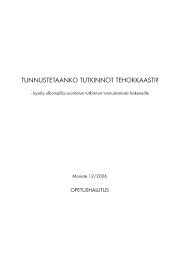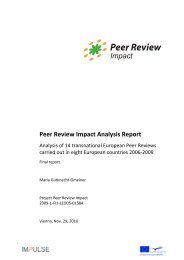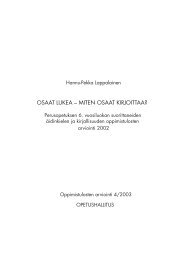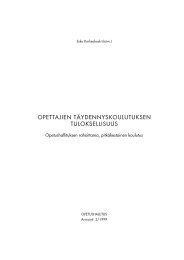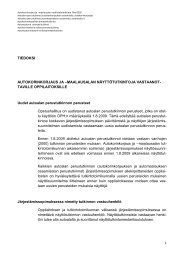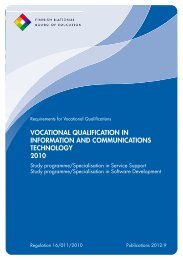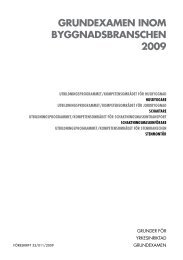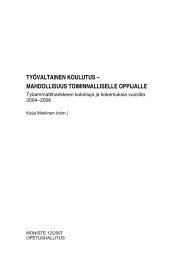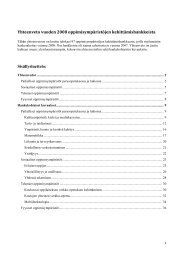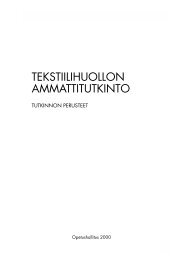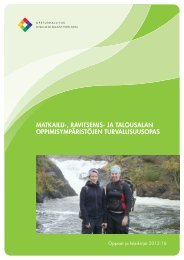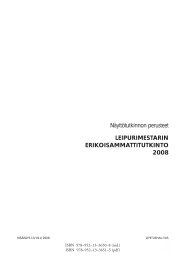KiVa – A national anti-bullying programme for Finnish schools
KiVa – A national anti-bullying programme for Finnish schools
KiVa – A national anti-bullying programme for Finnish schools
Create successful ePaper yourself
Turn your PDF publications into a flip-book with our unique Google optimized e-Paper software.
Children’s rights and safe learning<br />
environment<br />
<strong>KiVa</strong> <strong>–</strong> A <strong>national</strong> <strong>anti</strong>-<strong>bullying</strong> program<br />
<strong>for</strong> <strong>Finnish</strong> <strong>schools</strong><br />
Pestalozzi 4.10.2012<br />
Kristiina Laitinen<br />
<strong>Finnish</strong> National Board of Education
Pupil welfare<br />
The Basic Education Act and education policy<br />
Education shall be provided and organized according to<br />
the pupils’ age and capabilities, and so as to promote<br />
pupils’ healthy growth and development.<br />
A pupil has the right to get instruction and guidance<br />
counselling in accordance with the curriculum and<br />
sufficient support in learning and school going, as soon<br />
as the need arises.
Pupil welfare<br />
The Basic Education Act and education policy<br />
A pupil is entitled to free pupil welfare which is<br />
necessary <strong>for</strong> participation in education.<br />
Pupil welfare means action promoting and maintaining<br />
good learning, good mental and physical health and<br />
social well-being, and conditions conducive to these.<br />
Pupil welfare encompasses<br />
• pupil welfare as determined in the curriculum adopted by the<br />
education provider and<br />
• pupil welfare services comprising school health care<br />
referred to in the Public Health Act (66/1972) and support<br />
to schoolgoing referred to in the Child Welfare Act 417/2007).
Pupil welfare<br />
The Basic Education Act and education policy<br />
Welfare consists of every day care and safe school<br />
environment, social and psychological support, heath<br />
and dental care, school meals and school transport.<br />
Holistic approach to well-being<br />
• child’s well-being as a prerequisite <strong>for</strong> learning<br />
• healthy growth and development<br />
• prevention and early intervention<br />
• subjective right to pupil welfare<br />
Safety<br />
• safe and healthy learning environment<br />
• plan <strong>for</strong> safeguarding pupils/students against violence, <strong>bullying</strong><br />
and harassment<br />
Cooperation<br />
• home-school cooperation<br />
• cross-sectoral cooperation
Be<strong>for</strong>e <strong>KiVa</strong><br />
<strong>Finnish</strong> school system is effective but it is not without problems<br />
• <strong>Finnish</strong> pupils report low ”school liking”<br />
(WHO’s HBSC-reports)<br />
Since the beginning of the 1990’s<br />
• A lot of public attention has been allocated to bully-victim problems<br />
on Finland<br />
• Changes in legislation (1998, 2003, 2010)<br />
”Self-invented programs” encouraged by legislation<br />
• Every school has to have a strategy or action plan against <strong>bullying</strong><br />
• No evidence-based <strong>bullying</strong> prevention programs available on the<br />
market<br />
Despite the actions taken, no changes in the prevalence of pupils<br />
<strong>bullying</strong> others / being bullied by others during ( 1998 <strong>–</strong> 2007, School<br />
Health Promotion Study).
Frequency of <strong>bullying</strong><br />
Freguency in <strong>Finnish</strong> comprehensive <strong>schools</strong> 5 <strong>–</strong> 10 %<br />
• The percentage varies from study to study<br />
• The persentage is higher in grades 1 to 6<br />
In Scandinavian comparison Finland and Denmark do worst;<br />
Sweden has least <strong>bullying</strong> in <strong>schools</strong><br />
In even wider perspective, Finland’s <strong>bullying</strong> persentage is<br />
”average”
Evidence-based <strong>bullying</strong> prevention<br />
programs are needed<br />
• Each school develops their own policy???<br />
• self-invented program self-invented program self-invented program<br />
self-invented program self-invented program self-invented program<br />
self-invented program self-invented program self-invented program ….<br />
• Improving the school climate<br />
• No evidence of mere ’positive climate’ or ’good atmosphere’ leading to<br />
reductions in <strong>bullying</strong><br />
• BUT there is evidence of the contary effect<br />
(e.g. Salmivalli, Grandeau & Veenstra 2012)<br />
• Latest meta-analyses by Ttofi & Farrington<br />
• 44 different studies<br />
• Conclusion: Anti<strong>bullying</strong> programs can <strong>–</strong> and they often do -<br />
work
<strong>KiVa</strong> <strong>anti</strong><strong>bullying</strong> program<br />
Taking action at the <strong>national</strong> level<br />
Kiva = ’nice, good, friendly’,…<br />
<strong>KiVa</strong> = ’Kiusaamista Vastaan’, Against Bullying<br />
Developed in the University of Turku in a development & research team<br />
• Professors Christina Salmivalli and Elisa Poskiparta<br />
• Ten PhD students<br />
• Teacher trainers<br />
Funded by the Ministry of Education and Culture<br />
• Development of the <strong>KiVa</strong> program and initial evaluation of the<br />
effectiveness 2006 <strong>–</strong> 2009<br />
• Beginning the broad implementation across <strong>Finnish</strong> comprehensive<br />
<strong>schools</strong> 2009 <strong>–</strong> 2010<br />
• Supporting high-quality implementation and sustainability across the<br />
country 2010 - 2011<br />
Research funding from the Academy of Finland
The social architecture of <strong>bullying</strong><br />
Bullying can be a strategy to gain status and power in<br />
the peer group - this strategy is often succesful<br />
• Bullies are perceived as popular (Caravita, DiBlasio & Salmivalli, 2008)<br />
• Bullying helps to maintain status (Juvonen & Calvan, 2008)<br />
• Bullying helps to increase status over time (Cillessen & Borch, 2004)<br />
In order to demonstrate their power and renew their high status<br />
position, bullies need to choose<br />
• Targets who are submissive, insecure of themselves, physically weak<br />
and in low-power, rejected position in the group …<br />
The power demonstrations need witnesses<br />
• Choosing optimal time and place <strong>for</strong> attacks<br />
• In most <strong>bullying</strong> incidents, a group of peers is present
10<br />
The social architecture of <strong>bullying</strong><br />
Participant roles in <strong>bullying</strong> (Salmivalli et al., 1996)<br />
12%<br />
rein<strong>for</strong>cers of the bully<br />
8%<br />
bully<br />
victim<br />
20%<br />
assistants of the bully<br />
7%<br />
outsiders<br />
17%<br />
24%<br />
defenders of the victim<br />
10
The behavior of onlookers/bystanders does<br />
matter<br />
Individual level<br />
• Short term: The defended victims are better adjusted than the<br />
undefended ones<br />
(Sainio, Veenstra, Huitsing & Salmivalli, 2011).<br />
• Long term: The most negative memory related to <strong>bullying</strong> is often<br />
that ’no one cared’<br />
(Teräsahjo & Salmivalli, 2000)
The behavior of onlookers/bystanders<br />
does matter<br />
Classroom level<br />
• In classrooms where rein<strong>for</strong>cing the bully is occurring at high<br />
levels and defending is rare<br />
• Bullying is more frequent<br />
(Salmivalli, Voeten, & Poskiparta, 2011)<br />
• Individual-level risk factors are more likely to lead to<br />
victimization<br />
(Kärnä, Voeten, Poskiparta, & Salmivalli, 2010)
In order to reduce <strong>bullying</strong><br />
We do not necessarily need to change the victims, making them<br />
”less vulnerable”.<br />
Influencing the behavior of classmates can reduce the rewards<br />
gained by the bullies and consequently, their motivation to bully in<br />
the first place<br />
→ UNIVERSAL ACTIONS<br />
However, the victims need to feel that they are heard and helped by<br />
the adults at school.<br />
The bullies need to be confronted <strong>for</strong> their unacceptable behavior.
In order to reduce <strong>bullying</strong><br />
We do not necessarily need to change the victims, making them<br />
”less vulnerable”.<br />
Influencing the behavior of classmates can reduce the rewards<br />
gained by the bullies and consequently, their motivation to bully in<br />
the first place.<br />
However, the victims need to feel that they are heard and helped<br />
by the adults at school.<br />
The bullies need to be confronted <strong>for</strong> their unacceptable behavior.<br />
→ INDICATED ACTIONS
What should an <strong>anti</strong><strong>bullying</strong> program<br />
include?<br />
Something <strong>for</strong> all students<br />
→ Universal interventions<br />
Something <strong>for</strong> bullies and victims in particular<br />
→ Indicated interventions
Special characteristics of <strong>KiVa</strong><br />
Special characteristics<br />
• Both universal and indicated actions<br />
• An exceptionally large amount of materials & concrete tools<br />
(not merely a ”philosophy”)<br />
• Utilizing ICT: virtual learning environments<br />
<strong>KiVa</strong> is more systematic and stuctured than most<br />
existing <strong>anti</strong>-<strong>bullying</strong> programs<br />
• What to do, when to do it, how to do it …
Universal actions<br />
• Awareness of the role bystanders play in the<br />
<strong>bullying</strong> process<br />
• Safe strategies to support and defend the victimized<br />
peers → self-efficacy <strong>for</strong> defending<br />
• based on common decisions in the group<br />
• not necessarily heroic acts of confronting the bullies
Universal actions<br />
• Commitment & coordination at the school level<br />
• Signaling that ’we are <strong>KiVa</strong> school’<br />
• Visible vests <strong>for</strong> teachers supervising recess time<br />
• Posters<br />
• Annual student online survey<br />
• Three developmentally approppriate versions <strong>for</strong> pupil lessons<br />
(grade levels 1-3, 4-6, and 7-9)<br />
• in primary school, 10 double lessons during the school year<br />
• in secondary <strong>schools</strong>, four ’themes’<br />
• An <strong>anti</strong>-<strong>bullying</strong> computer game / virtual learning environment<br />
• A parents’ guide<br />
• Virtual ”mailbox”
The themes of the <strong>KiVa</strong> lessons<br />
(Grades 4 <strong>–</strong> 6)<br />
1. Respect is <strong>for</strong> everybody<br />
2. In a group<br />
3. Recognize <strong>bullying</strong><br />
4. Hidden <strong>for</strong>ms of <strong>bullying</strong><br />
5. Consequences of <strong>bullying</strong><br />
6. Group involvement in <strong>bullying</strong><br />
7. Countering <strong>bullying</strong> as a group<br />
8. What to do if I get bullied?<br />
9. <strong>KiVa</strong> Koulu <strong>–</strong> let’s do it together<br />
10. How are we doing?
Universal actions<br />
Student lessons<br />
20
<strong>KiVa</strong> computer game:<br />
Characters from the virtual school (Grades 4-6)
Computer games and virtual learning<br />
environments<br />
<strong>KiVa</strong> Game <strong>KiVa</strong> Street
<strong>KiVa</strong> games and <strong>KiVa</strong> Street are closely<br />
connected to student lessons
<strong>KiVa</strong> games and <strong>KiVa</strong> Street are closely<br />
connected to student lessons<br />
Enhancing awareness of the role bystanders play in the <strong>bullying</strong><br />
process, as well as empathy <strong>for</strong> victims.<br />
Providing self-efficacy and safe strategies to support and<br />
defend the victimized peers
<strong>KiVa</strong> games and <strong>KiVa</strong> Street are closely<br />
connected to student lessons<br />
• Repeating & testing of what has been learnt<br />
→”I KNOW”<br />
• Learning to take action<br />
→”I CAN”<br />
• Motivation<br />
→”I DO”
Parents’ quide and website
Virtual ”mailbox”<br />
However: only a minority of cases came to attention and<br />
were directed to school teams.<br />
New feature in <strong>KiVa</strong> computer game<br />
• Virtual ”mailbox”<br />
• Possibility to send a message to own school’s <strong>KiVa</strong> team
Virtual ”mailbox”
Indicated actions <strong>–</strong><br />
tackling the cases of <strong>bullying</strong> coming to attention<br />
Individual discussions with the victim and with the<br />
<strong>bullying</strong> children<br />
→ KIVA TEAM<br />
• Two different approaches were tested<br />
Utilizing prosocial, high-status peers<br />
• ”Your help is needed”<br />
→ CLASSROOM TEACHER<br />
• setting standards <strong>for</strong> others<br />
• making the victim feel better<br />
• protecting the victimized child from further attacks
Evaluation of Kiva<br />
<strong>KiVa</strong> was put in an extremely rigorous test<br />
Randomized controlled triad (RTC)<br />
• 2007- 2008<br />
• 2008-2009<br />
• Was possible in the beginning, not anymore<br />
Evaluation during broad rollout; age cohort design<br />
• Since 2009
Randomized controlled triad (RTC)<br />
Biggest randomized control trial ever<br />
• 234 <strong>schools</strong> (117 intervention, 117 control) representing<br />
all provinces in the mainland Finland and both <strong>Finnish</strong>-<br />
and Swedish-speaking <strong>schools</strong><br />
• Over 30 000 students<br />
• Exceptionally wide age range<br />
• grades 1-9<br />
• pupils with 7-15 years of age<br />
• Numerous outcome variables
Randomized controlled triad<br />
Success of the indicated actions<br />
The proportion of cases handled by the school team in<br />
which <strong>bullying</strong><br />
1. Stopped completely 79.4%<br />
2. Decreased 18.5%<br />
3. Remained the same 1.9%<br />
4. Increased 0.3%<br />
(Garandeau et al., Tackling acute cases of <strong>bullying</strong>: Comparison of<br />
two methods in the context of the <strong>KiVa</strong> <strong>anti</strong><strong>bullying</strong> program).
First phase of evaluation (2007<strong>–</strong>2008)<br />
Randomized controlled triad<br />
Results<br />
After controlling <strong>for</strong> other predictor variables in the<br />
model(s), the risk <strong>for</strong> <strong>bullying</strong> others and <strong>for</strong> being<br />
victimized by others was halved after one school year of<br />
implementation of <strong>KiVa</strong> program.<br />
Other positive results (significant)<br />
• School liking increased (all pupils)<br />
• Learning motivation increased (all pupils)<br />
• Depression and anciety decreased<br />
• Head masters’ specific support to <strong>KiVa</strong> important
First phase of evaluation (2007<strong>–</strong>2008)<br />
Randomized controlled triad<br />
Main conclusions<br />
• <strong>KiVa</strong> was effective in reducing (self- and peer-reported)<br />
<strong>bullying</strong> and victimization, already during the first nine months<br />
of implementation.<br />
• The effects generalize to multiple <strong>for</strong>ms of victimization.<br />
• Numerous positive effects on other outcomes (emotional,<br />
cognitive, as well as behavioral).<br />
• Effects varied across grade levels, being strongest in grade 4<br />
and weakest in secondary school (grades 7-9).<br />
• Indicated actions were often effective, but taken in a minority<br />
of <strong>bullying</strong> cases
Evaluation under broad rollout (2009 -)<br />
Results<br />
The persentage of <strong>bullying</strong> decreased by approximately<br />
• 15 % in all grade levels<br />
• 20 % in primary school (grades 1-6)<br />
Notice:<br />
The <strong>KiVa</strong> School of the Year 2011<br />
• Polvijärvi Secondary School:<br />
• The persentage of children being victimized by others<br />
decreased by 56 %<br />
• The persentage of children <strong>bullying</strong> others decreased by 90 % !<br />
• Karamzin Primary school:<br />
The persentage of children being victimized by others<br />
decreased by 67 %
Evaluation under broad rollout<br />
Main conclusions<br />
• Effects seem to be weaker than in RTC, but still significant with<br />
much variation across grade levels.<br />
• Again, strongest effects in grade 4 and weakest in grades 7 <strong>–</strong> 9<br />
(secondary school).<br />
• Generalized to <strong>Finnish</strong> population of 500 000 students, the<br />
effects of this size would mean a reduction of 12 000 victims and<br />
8 000 bullies after nine months of implementation of <strong>KiVa</strong>.<br />
More data comes in every year<br />
• 2009, 2010, 2011, 2012, 2013, 2014, 2015….<br />
• About <strong>bullying</strong>, victimization, implementation fidelity…
Primary <strong>schools</strong>
Scaling up<br />
Diffusion<br />
2009: 1450 <strong>schools</strong><br />
2010: + 810 <strong>schools</strong><br />
2011: + 200 <strong>schools</strong> + Åland Island<br />
90% of comprehensive <strong>schools</strong> in the country have<br />
adopted KIVa.<br />
About 7500-8000 teachers and other school personnel<br />
have been trained face-to-face.
The future of <strong>KiVa</strong>:<br />
Maintaining high-quality implementation in Finland<br />
• On-line training <strong>for</strong> school personnel (10 hours)<br />
• Lectures<br />
• Interviews (head masters, teachers, <strong>KiVa</strong> teams…)<br />
• Films of lessons at classrooms<br />
• Simulations of discussions with the victim and the bullies<br />
• Discussion <strong>for</strong>um <strong>for</strong> school personnel<br />
• Newsletters (4 / school year)<br />
• Biannual <strong>KiVa</strong> Days (since 2010)<br />
• Quality recommendations<br />
• Annual The <strong>KiVa</strong> School of the Year award
The future of <strong>KiVa</strong>:<br />
Maintaining high-quality implementation in Finland<br />
• Yearly on-line surveys (Students / Staff)<br />
→ Automatic and individual feedback to <strong>schools</strong><br />
• <strong>KiVa</strong> resource <strong>schools</strong><br />
• Piloting begins in 2012<br />
• New products to complement existing <strong>KiVa</strong> materials
The future of <strong>KiVa</strong>:<br />
Research challenges<br />
• Mediators and moderators of effects<br />
• Implementation & sustainability issues<br />
• New projects<br />
• follow-up of one whole cohort of children<br />
• <strong>KiVa</strong>-twins<br />
• ECRP project on <strong>bullying</strong> and victimization networks
The future of <strong>KiVa</strong>:<br />
Inter<strong>national</strong> evaluations underway<br />
• Sweden (Lerum)<br />
• Netherlands (multi-site study)<br />
• USA (Kansas)<br />
• Puerto Rico<br />
• Wales …<br />
In addition to <strong>Finnish</strong> and Swedish, the material is being<br />
translated into English, Spanish, Flamish (Dutch),<br />
Japanese, …
<strong>KiVa</strong> is exceptional in many ways<br />
<strong>KiVa</strong> can be seen as an example of how commitment from part of<br />
politicians, researchers, and educators can make a difference in the lives of<br />
numerous children and youth.<br />
• The effectiveness of the program is outstanding<br />
• The Ministry of Education and Culture has funded the development of<br />
the program<br />
• Over 30 000 children took part<br />
• The Ministry of Education and Culture has provided the funding of the<br />
<strong>national</strong> diffusion of the program<br />
• Using Kiva is free of costs to <strong>schools</strong><br />
• European Crime Prevention Award (2009)<br />
• Three <strong>national</strong> awards (2008, 2010, 2011)<br />
• Social Policy Award <strong>for</strong> the Best Article, Society <strong>for</strong> research on<br />
Adolescence (2012)
Some references<br />
Kärnä, A., Voeten, M., Little, T., Poskiparta, E., Kaljonen, A., & Salmivalli, C. (2011).<br />
A large-scale evaluation of the <strong>KiVa</strong> <strong>anti</strong><strong>bullying</strong> program: Grades 4-6. Child<br />
development, 82, 311-330.<br />
Kärnä, A., Voeten, M., Little, T., Alanen, E., Poskiparta, E., & Salmivalli, C. (under<br />
review). Effectiveness of the <strong>KiVa</strong> <strong>anti</strong><strong>bullying</strong> program: Grades 1-3 and 7-9.<br />
Salmivalli, C., Kärnä, A., & Poskiparta, E. (in press). Counteracting <strong>bullying</strong> in<br />
Finland: The <strong>KiVa</strong> program and its effects on different <strong>for</strong>ms of being bullied.<br />
IJBD.<br />
Kärnä, A., Voeten, M., Little, T., Alanen, E., Poskiparta, E., & Salmivalli, C. (revision<br />
submitted) Going to Scale: The effectiveness of <strong>KiVa</strong> <strong>anti</strong><strong>bullying</strong> program during<br />
the first year of nationwide implementation. Journal of Consulting and Clinical<br />
Psychology.<br />
Willi<strong>for</strong>d, Boulton, Noland, Little, & Salmivalli (in press). The effects of KIVa<br />
<strong>anti</strong><strong>bullying</strong> program on depression, anxiety, and negative peer perceptions.<br />
Journal of Abnormal Child Psychology.<br />
Salmivalli, Garandeau, & Veenstra (in press). Effects of the <strong>KiVa</strong> <strong>anti</strong><strong>bullying</strong><br />
program on school adjustment.
www.kivakoulu.fi



